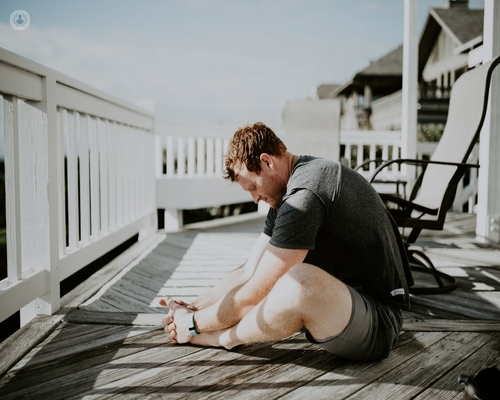Hip pain: causes and how to manage it at home
Written by:There are many conditions that can cause hip pain with the most common being osteoarthritis. The symptoms can vary in each case but it’s typical to feel pain, stiffness and to have a limitation in doing certain activities. We were fortunate enough to talk to one of our expert orthopaedic surgeons Mr Syed Ahmed about the different types of hip pain and how you can manage it at home.

What is the most common cause of hip pain?
The most common cause of hip or groin pain in adults is arthritis of the hip joint itself. This can lead to discomfort, pain and functional limitations.
Arthritis of the hip could cause inflammation of the hip joint and soft tissue surrounding it. It also leads to damage of the cartilage on the surface of the joint and new bone formation around the joint, which attributes to the stiffness and pain experienced by the individual.
What are other causes of hip pain?
The other main causes of pain in young adults are:
- Femoro-acetabular impingement - which is caused by abnormal bony growth rubbing together during specific movements.
- Cartilage tear in the hip joint - known as a labral tear.
- Trauma – causing a fracture.
- Sporting injuries – leading to a tear of the hamstring muscles or a sprain of the iliotibial band.
- Inflammation of the bursa around the hip.
- Osteonecrosis – reduced oxygen to the femoral head (hip joint) causing the death of bone tissue in the hip joint. Causes significant pain and could lead to the subsequent destruction of the joint.
Why does hip pain radiate to the knee?
This is known as referred pain. In simple terms, it is a result of the same nerve fibres innervating both the hip and knee.
Is the pain due to an arthritic spine?
This may well be true. Hip joint pathology usually causes groin pain. However, sharp shooting pain radiating from the lower back going into the buttock and potentially down the back of the leg is characteristic of sciatica.
A part of the orthopaedic examination is to differentiate if the pain originates from the spine or the hip itself. Occasionally, further investigations such as an MRI scan may be required to confirm the diagnosis prior to deciding on management.
How can you manage the pain at home?
Things that one may find useful in order to reduce the symptoms of arthritis include the following:
- Regular exercise
- Weight loss – reduced the force going through the joint
- Wearing comfortable shoes
- Seeing a physiotherapist for conditioning exercises
- Regular analgesia which includes paracetamol and anti-inflammatories such as ibuprofen.
Certain high-impact activities could make hip pain worse. For example, running on the hard-tarmac outdoors leads to significant amounts of forces going through your hip and knee joints. Therefore, low impact activities such as cycling and swimming are encouraged.
Mr Ahmed is an expert in treating hip and knee conditions. You can make an appointment to see him via his Top Doctor’s profile here. He is also available for a video call using our e-Consultation tool, which also appears on his profile.


